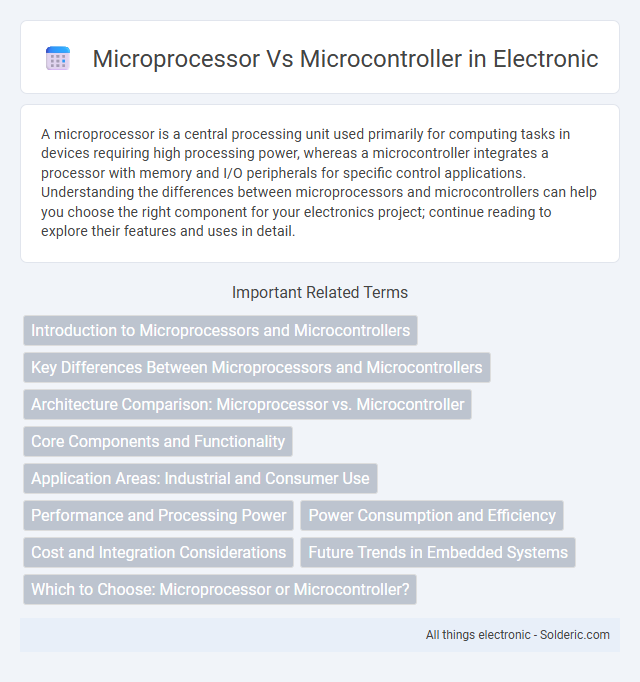A microprocessor is a central processing unit used primarily for computing tasks in devices requiring high processing power, whereas a microcontroller integrates a processor with memory and I/O peripherals for specific control applications. Understanding the differences between microprocessors and microcontrollers can help you choose the right component for your electronics project; continue reading to explore their features and uses in detail.
Comparison Table
| Feature | Microprocessor | Microcontroller |
|---|---|---|
| Definition | Central Processing Unit (CPU) on a single chip | CPU with integrated memory and peripherals on one chip |
| Components | Only CPU core | CPU, RAM, ROM, I/O ports, timers |
| Application | Complex computing tasks, PCs, laptops | Embedded systems, control applications |
| Cost | Higher due to external components | Lower, all-in-one solution |
| Power Consumption | Higher, needs external components | Lower, optimized for low-power |
| Speed | Higher clock speeds | Moderate speed, optimized for control tasks |
| Memory | External RAM and ROM required | On-chip memory available |
| Use Case Example | Intel Core i7 in desktops | ARM Cortex-M in IoT devices |
Introduction to Microprocessors and Microcontrollers
Microprocessors are central processing units designed primarily for general-purpose computing tasks, relying on external components like memory and I/O devices to function. Microcontrollers integrate a microprocessor core with memory and peripherals on a single chip, providing an all-in-one solution ideal for embedded systems. Understanding these fundamental differences helps you choose the appropriate technology for applications requiring either complex processing or efficient control.
Key Differences Between Microprocessors and Microcontrollers
Microprocessors are designed primarily for complex computing tasks, featuring high processing power, large memory capacity, and requiring external peripherals for functionality, making them ideal for PCs and laptops. Microcontrollers integrate a CPU, memory, and input/output peripherals on a single chip, providing cost-effective, compact, and efficient solutions for embedded systems and real-time control applications. The key differences include architecture complexity, power consumption, cost, and applications, with microprocessors suited for general-purpose computing and microcontrollers for dedicated, application-specific tasks.
Architecture Comparison: Microprocessor vs. Microcontroller
Microprocessors feature a central processing unit (CPU) that relies on external components like memory and input/output (I/O) interfaces, resulting in a flexible but complex system architecture. Microcontrollers integrate the CPU, memory (RAM and ROM), and peripherals on a single chip, optimizing them for embedded applications with limited space and power consumption. The microcontroller's architecture is designed for real-time control and embedded system efficiency, while microprocessors prioritize high computational power and versatility.
Core Components and Functionality
Microprocessors consist primarily of a central processing unit (CPU) and rely on external components like memory and input/output controllers for functionality, making them ideal for complex computational tasks. Microcontrollers integrate a CPU, memory (both RAM and ROM), and peripheral input/output interfaces on a single chip, enabling efficient control in embedded systems. Your choice depends on whether your project demands standalone processing power or compact, dedicated control with embedded resources.
Application Areas: Industrial and Consumer Use
Microprocessors are primarily used in industrial applications requiring high processing power, such as automation systems, data servers, and complex robotics, where flexibility and speed are crucial. Microcontrollers excel in consumer products like home appliances, automotive control systems, and wearable devices due to their integrated peripherals and cost-effective design. Your choice depends on whether the application demands intensive computation or embedded control functionality.
Performance and Processing Power
Microprocessors typically offer higher performance and processing power due to their ability to operate at faster clock speeds and handle complex computations with multiple cores and advanced architectures. Microcontrollers integrate a CPU with memory and peripherals on a single chip, optimizing them for real-time control tasks but generally providing lower clock speeds and simpler processing capabilities. The choice between microprocessor and microcontroller depends on application requirements, where intensive data processing favors microprocessors, while embedded system control suits microcontrollers.
Power Consumption and Efficiency
Microcontrollers typically exhibit lower power consumption compared to microprocessors due to their integrated design tailored for specific control tasks, enabling efficient energy use in embedded systems. Microprocessors require more power as they handle complex operating systems and multitasking applications, often resulting in higher energy demands. This makes microcontrollers ideal for battery-powered and low-energy applications, while microprocessors are better suited for performance-intensive computing where power availability is less constrained.
Cost and Integration Considerations
Microcontrollers typically offer lower cost and higher integration by combining a CPU, memory, and peripherals on a single chip, making them ideal for cost-sensitive and compact applications. Microprocessors require external components such as RAM and peripherals, increasing overall system cost and design complexity. Cost efficiency and integration make microcontrollers the preferred choice for embedded systems, while microprocessors suit applications demanding higher processing power and flexibility.
Future Trends in Embedded Systems
Advancements in embedded systems indicate a growing shift toward microcontrollers due to their integrated peripherals, low power consumption, and cost-effectiveness, making them ideal for IoT and edge computing applications. Microprocessors, with their high processing power and flexibility, remain crucial for complex tasks in AI, robotics, and real-time data analysis, driving innovation in autonomous systems. Your choice between microprocessor and microcontroller will depend on the specific needs of future embedded solutions, balancing performance, integration, and application complexity.
Which to Choose: Microprocessor or Microcontroller?
Choosing between a microprocessor and microcontroller depends on your project's complexity and application requirements. Microprocessors offer higher processing power and are ideal for tasks needing extensive data handling or running complex operating systems. Your decision should consider microcontrollers for embedded systems where cost, power consumption, and real-time control are critical.
microprocessor vs microcontroller Infographic

 solderic.com
solderic.com